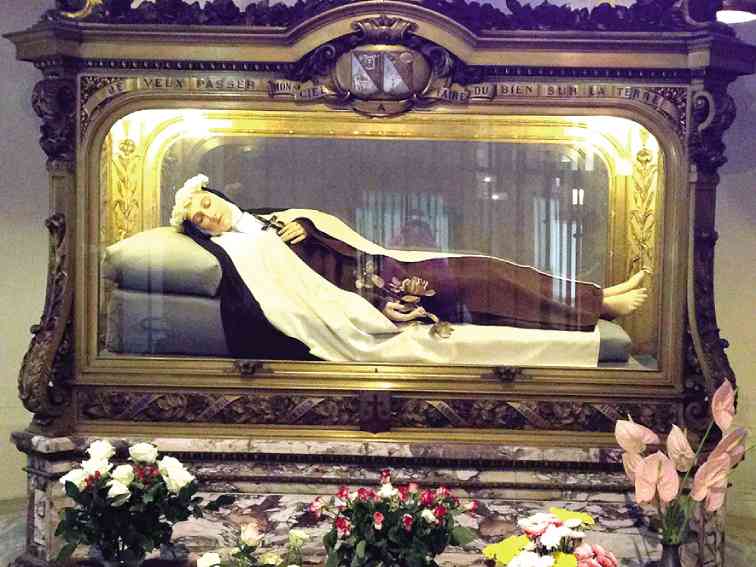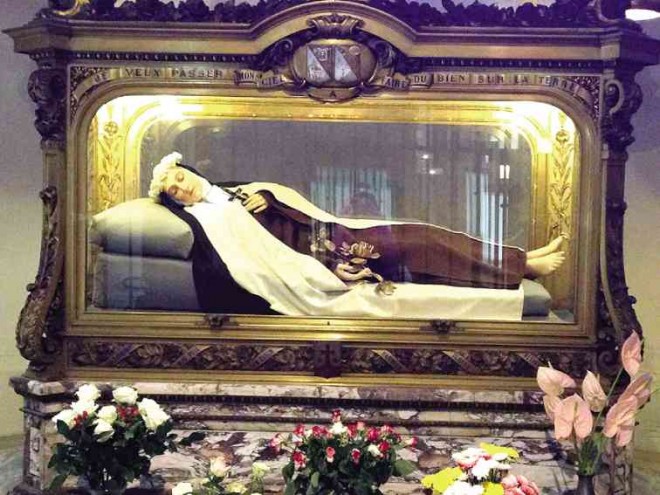
I had almost cancelled my trip to Lisieux to visit an old friend. And then she appeared in my dream, smiling, and I knew I just had to go.
My childhood school friends and I have been praying to her to fix boyfriend woes, parent problems and our futures since we were in high school.
She is St. Thérèse of the Child Jesus, Lisieux, and the Holy Face, aka Marie Françoise Thérèse Guérin Martin, pronounced “The-REZ”; we even dropped the “Saint” most of the time, referring to her only by her first name, as in, “Yay, sinagot na ako ni Thérèse!”
This was, after all, the Catholic saint who, supremely confident that she would shoot straight up to her beloved Jesus’ side, promised that “I will spend my heaven doing good upon earth; I will let fall a shower of roses.” And yes, believe it or not, my friends and I did get many roses.
We never quite stopped praying to Thérèse as we grew older, and when I was diagnosed with breast cancer last year, I naturally asked her to help keep me calm in the midst of battle. And she did.
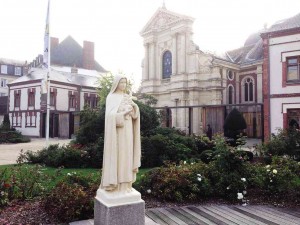
Even before my diagnosis at age 48, I was already saving up for my 50th birthday, which I had planned to celebrate on a solo journey to Europe, specifically to visit my favorite saints, Thérèse and the protector of my beloved dogs, Francis of Assisi (more on him in a future issue). Thus, after I was given a clean bill of health, the need to soul-search—and to give thanks to my sponsors, as it were—proved even more urgent.
Reverential silence
Lisieux, in the Basse-Normandie region of southwestern France, is a small place; you can walk from one end to the other in an hour. Getting off the train from Paris’ Gare St. Lazare on a late summer’s day, I was struck by the almost reverential silence in the air.
If you’re not interested in Thérèse or her life, a day in Lisieux will probably suffice. Most of the visitors, however, are pilgrims on religious tours or retreats, on the way to other shrines in Europe. I was determined to stay a bit, and soak in as much of Thérèse’s energy as I could.
That proved to be easy; save for a trip to Italy with her father Louis and sister Celine in 1887, Thérèse had a relatively sheltered, seemingly uneventful life. She was born in nearby Alençon on Jan. 2, 1873, but lost her mother Zélie to breast cancer (!) when she was only 4 years old.
Louis then moved his five surviving daughters to Lisieux to be near relatives. Two older daughters, Pauline and Marie, entered Carmel, and Thérèse would soon follow, on April 9, 1888, at age 15. She would die of tuberculosis inside the convent only nine years later, at age 24.
It was because of her autobiography, “The Story of A Soul,” written two years before her death upon the orders of her Mother Superior (the wise woman probably sensed that this girl was special), that the nun became a rock star of the Catholic church.
Aside from documented miracles, she drew many converts to the path she called “The Little Way” of spiritual childhood, a refreshing philosophy that fast-tracked Thérèse’s own road to sainthood; she was canonized on May 17, 1925.

Pope Pius X called her “the greatest saint of modern times,” and in 1997, Pope John Paul II declared her a Doctor of the Church. The Little Flower took her place alongside intellectual giants like Saints Augustine, Thomas Aquinas and Teresa of Avila.
Lisieux literally makes stalking Thérèse even easier, as the town invites visitors to walk “sur le pas de Thérèse,” in the footsteps of Thérèse; the streets to important sites are painted with a blue line.
No WiFi
My home for four days, L’Ermitage Sainte Thérèse, provides accommodations right along this route strictly for pilgrims, run by missionaries.
We’re talking no WiFi, no TV, a 10 p.m. curfew, and basic French breakfasts (read: crusty baguettes) and dinners in common dining rooms. The rooms are simple but comfortable; my own room had a view of the gardens, and a smiling photograph of Thérèse watching over my sleep.
“I can’t believe I’m here at last,” I whispered to Thérèse when I arrived. Still, I couldn’t dump my suitcase in the room fast enough before running back down to the Carmel, conveniently located just next door.
Founded in 1838, this was where Thérèse lived from April 1988 to her death.
There is a lovely little chapel where the Carmelites pray every day. There’s a small museum featuring objects and videos on life in the convent, and a bookshop filled with souvenirs.
Right beside the chapel, however, devoid of glitter and finery, was my ground zero—the shrine of St. Thérèse.
Above her remains is an exquisite statue representing the saint on her deathbed, eyes closed and clutching flowers to her chest, in a room suffused with the scent of flowers.
Nuns came in daily to arrange vases of blooms, and to pick up those offered through the iron grills by visitors. Looming above the sleeping saint was the Virgin of the Smile, the actual image that smiled at Thérèse and cured her of a nervous breakdown after the departure of her sister, Pauline, for Carmel.
I don’t remember how long I knelt there, clutching the grills and sobbing. A nun smiled at me knowingly. Through the eyes of my heart, I could see my old friend smiling at me, too, in her sleep, as if to say, “Finally!”
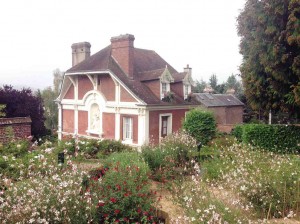
Morning mass at Carmel and a hello to Thérèse started my day for the next three blessed days. It took me one full day to walk a few minutes uphill and explore the grandeur of the Basilica of St. Thérèse—“an image of the saint’s rapid posthumous glory,” a local guidebook explains.
‘Very big, very beautiful’
Indeed, Pope Pius XI wanted a structure “very big, very beautiful and built very quickly” in tribute to Thérèse. The first stone was laid in 1929, and the 4,500-sq m basilica, designed by French architect L. M. Cordonnier and filled with dazzling mosaics by father-and-son master glassworkers Jean and Pierre Gaudin, was consecrated in 1954.
Images of Lisieux’s beloved patroness fill the cavernous church, including one of Jesus flanked by his mother and Thérèse on the apse, and on the brilliant dome, Thérèse’s coronation in heaven. A golden reliquary holding the bones of her right arm can be found on one side of the church, and is carried in a procession during her feast day.
More brilliant mosaics can be found in the underground crypt, where the remains of Thérèse’s parents, Louis and Zélie Guérin Martin, are kept. In an unprecedented move by the Church, the Martins, deeply religious even before Thérèse was born, were beatified as a couple in 2008, and devotees are now rallying for their canonization.
At the side of the basilica, a diorama of life-sized wax figures illustrating episodes in Thérèse’s life, complete with audio tour, helps make her story come alive. Across the basilica entrance, the Centre Pastoral John Paul II is also a great stop for souvenirs, information, snacks, and to view a video on the saint’s life. Behind the huge church, a Way of the Cross is set amid beautiful greenery.
The next day, I walked to Thérèse’s home, the stately Les Buissonnets (“the bushes”), what she called “the sweet nest of childhood” where she lived from age 5 until she entered Carmel.
Inside are original furniture and decorations, including a clock Louis Martin made himself (he was a watchmaker), toys and the very bed where Thérèse lay tormented until she was cured by the Virgin Mary. On the wall of her bedroom, beautifully framed and preserved, was a relic I almost wanted to touch: lush ringlets of Thérèse’s real hair, framed under glass.
Behind the house is a beautiful garden, filled with trees, hidden benches and pens where the Martin children kept pets like chickens and rabbits. It’s a perfect place to imagine what the saint’s early years must have been like, running around as she played with her dog, Tom.
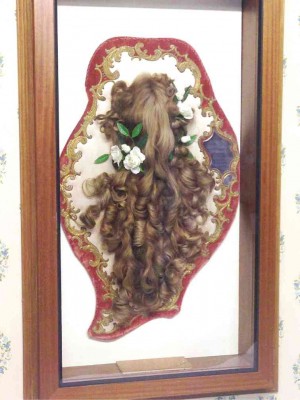
In the middle of the garden, however, is an especially touching statue depicting Thérèse begging a stoic Louis for permission to enter the convent. By all accounts, Louis willingly gave up his two elder daughters to the cloister, but found it especially hard to let go of his youngest and the apple of his eye, Thérèse, whom he called his “little queen.”
In fact, another daughter, Celine, would care for Louis until his death before she, too, followed her sisters to the convent. A painter and amateur photographer, Celine took many pictures of the Carmelites, and it is because of her that images of a shyly smiling Thérèse exist.
All of Thérèse’s older sisters—Marie, Pauline, Leonie and Celine—lived to see their little sister declared a saint, by the way.
The next day, my last full day in Lisieux, I returned to the basilica and sat for a long while at a picnic table amid trees near the stately campanile or bell tower, listening to the exquisite ringing of the 51 bells, believed to be among the finest in Europe. The biggest is a nine-ton beauty christened—what else—“Thérèse, Protectress of the Peoples.”
In the soft afternoon light, I sat and talked to my old friend, thanking her for her years of love and asking that she guide me for the rest of my life.
I felt myself pulled back into the basilica for one last goodbye, and there, among the many little altars dedicated by different nations to Thérèse, I saw a sign with her reassuring words: “I am your sister and your friend. I shall always be watching over you.”
Good to know, old friend.

